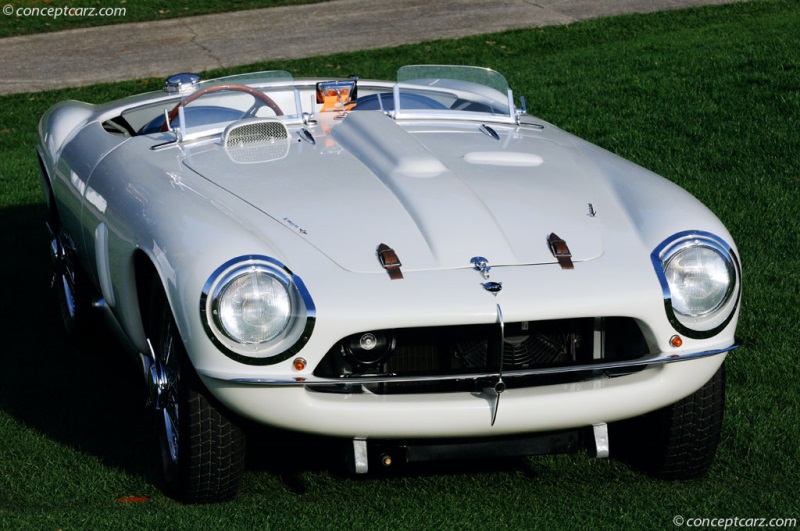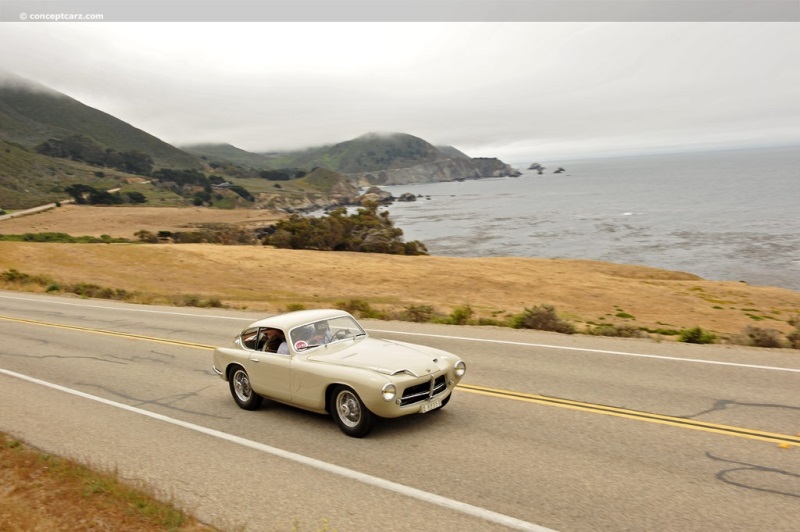History
Named after Pegasus, the winged horse of Greek mythology, the Pegaso Car Company produced very rare and exotic sports vehicles. Wilfredo Ricart was one of Enzo Ferrari's colleagues at Alfo Romeo's race department. He left Alfa Romeo after the war and teamed p with various engineers and technicians to begin working on their own vehicle. This eventually resulted in the Pegaso Z102.
A very modern race-bred V8 engine was placed in the Pegaso Z102 which made it a supreme competition for vehicles built in Maranello, Italy. The Pegaso was fitted with double overhead camshafts, a feature that had been confined to competition vee-type engine, though they were utilized on Jaguar's famous XK120 inline-six. The engine also featured sodium-filled exhaust valves for cooling, an oil cooler, and dry-sump lubrication while also using extensive use of light alloy. The option of one, two or four Weber carburetors could be fitted while compression ratios ranged from 7.8:1 to 9.0:1 to keep up with post-war Spain's unpredictable gasoline octane.
Receiving the elite status of being the only Spanish car to receive international supercar status during the 1950s, the Pegaso Z102B was introduced in 1951 at the Paris Auto Salon. With a top speed of 140 mph, the vehicle featured 250 horsepower at 6300 rpm. The Pegaso Company was government-backed at the time and had extensive experience constructing large 9-liter coaches. No one expected such a cutting-edge sports vehicle from a bus and truck company. Arond 125 Z102's were produced, with only two of them ever receiving bodywork from Saoutchik.
The Pegaso was a replacement for the esteemed Hispano-Suiza and was created to be a sports vehicle of the highest quality. Producing up to 300 hp, all Pegasos was powered by dry-sump V8 engines that ranged from 2.8 to 4.7 liters and featured torsion bar suspension along with 5-speed gearboxes with ZF limited-slip differentials. The 2.5 liter Z102 achieved 50 mph in just 8.3 seconds and 0-100mph in 35.0 seconds and had a top speed of 100 mph.
The Z102 range comprised a glass-backed coupe, a 2-seater cabriolet by Saotchik, a 2/3-seater Berlinetta, and a 2-seater sports model constructed by Superleggera Touring of Milan.
The Pegaso Z102B featured an increased engine with 2,816cc by 1953. The very exotic 'Thrill Berlinette' by Superleggera Touring was added to the range. The Z102B featured very aerodynamic side panels that blended from the rear body into the roof to form stabilizing 'fins' on each side. Considered to be the best known of all Pegaso's, the Z102B featured very exclusive red and black paintwork along with polished spoked wheels.
Pegaso models were largely hand-built and very innovative and advanced for their time. Only 88 models were ever built due to their extremely hefty price tag. Production ended in 1958 and the Pegaso resumed exclusively producing trucks and buses.By Jessica Donaldson
A very modern race-bred V8 engine was placed in the Pegaso Z102 which made it a supreme competition for vehicles built in Maranello, Italy. The Pegaso was fitted with double overhead camshafts, a feature that had been confined to competition vee-type engine, though they were utilized on Jaguar's famous XK120 inline-six. The engine also featured sodium-filled exhaust valves for cooling, an oil cooler, and dry-sump lubrication while also using extensive use of light alloy. The option of one, two or four Weber carburetors could be fitted while compression ratios ranged from 7.8:1 to 9.0:1 to keep up with post-war Spain's unpredictable gasoline octane.
Receiving the elite status of being the only Spanish car to receive international supercar status during the 1950s, the Pegaso Z102B was introduced in 1951 at the Paris Auto Salon. With a top speed of 140 mph, the vehicle featured 250 horsepower at 6300 rpm. The Pegaso Company was government-backed at the time and had extensive experience constructing large 9-liter coaches. No one expected such a cutting-edge sports vehicle from a bus and truck company. Arond 125 Z102's were produced, with only two of them ever receiving bodywork from Saoutchik.
The Pegaso was a replacement for the esteemed Hispano-Suiza and was created to be a sports vehicle of the highest quality. Producing up to 300 hp, all Pegasos was powered by dry-sump V8 engines that ranged from 2.8 to 4.7 liters and featured torsion bar suspension along with 5-speed gearboxes with ZF limited-slip differentials. The 2.5 liter Z102 achieved 50 mph in just 8.3 seconds and 0-100mph in 35.0 seconds and had a top speed of 100 mph.
The Z102 range comprised a glass-backed coupe, a 2-seater cabriolet by Saotchik, a 2/3-seater Berlinetta, and a 2-seater sports model constructed by Superleggera Touring of Milan.
The Pegaso Z102B featured an increased engine with 2,816cc by 1953. The very exotic 'Thrill Berlinette' by Superleggera Touring was added to the range. The Z102B featured very aerodynamic side panels that blended from the rear body into the roof to form stabilizing 'fins' on each side. Considered to be the best known of all Pegaso's, the Z102B featured very exclusive red and black paintwork along with polished spoked wheels.
Pegaso models were largely hand-built and very innovative and advanced for their time. Only 88 models were ever built due to their extremely hefty price tag. Production ended in 1958 and the Pegaso resumed exclusively producing trucks and buses.By Jessica Donaldson
Similarly Sized Vehicles
from 1953
1953 Pegaso Z102 Vehicle Profiles
Recent Vehicle Additions
Performance and Specification Comparison
Z102B Specification Comparison by Year
Year
Production
Wheelbase
Engine
Prices
92.00 in.
8 cyl., 150.85 CID.
8 cyl., 150.85 CID., 165.00hp
8 cyl., 171.84 CID., 170.00hp
8 cyl., 193.93 CID., 200.00hp
8 cyl., 171.84 CID., 250.00hp
8 cyl., 193.93 CID., 275.00hp
8 cyl., 150.85 CID., 165.00hp
8 cyl., 171.84 CID., 170.00hp
8 cyl., 193.93 CID., 200.00hp
8 cyl., 171.84 CID., 250.00hp
8 cyl., 193.93 CID., 275.00hp
92.00 in.
8 cyl., 150.85 CID.
8 cyl., 150.85 CID., 165.00hp
8 cyl., 171.84 CID., 170.00hp
8 cyl., 193.93 CID., 200.00hp
8 cyl., 150.85 CID., 165.00hp
8 cyl., 171.84 CID., 170.00hp
8 cyl., 193.93 CID., 200.00hp
92.00 in.
8 cyl., 150.85 CID.
8 cyl., 171.84 CID., 170.00hp
8 cyl., 193.93 CID., 275.00hp
8 cyl., 171.84 CID., 170.00hp
8 cyl., 193.93 CID., 275.00hp
$18,050 - $18,050
Related Automotive News

Audrain Collection's 1953 Pegaso Z-102 Touring Coupe Takes Home a Class Award at 72nd Pebble Beach Concours d'Elegance
The Pegaso class at the 72nd Pebble Beach Concours dElegance® was strongly contested and when all the scoring sheets were tallied the immaculately presented 1953 Pegaso Z-102 Touring Coupe owned by the Audrain Collection of Newport, RI, took home the...
BESPOKE FERRARI 250 GT HEADLINES THE BONHAMS|CARS MONACO SALE AS WE RETURN TO THE ICONIC VILLA LA VIGIE
Monte Carlo, Monaco – At The Monaco Sale Les Grandes Marques à Monaco, BonhamsCars will offer an unparalleled 1960 Ferrari 250 GT Coupé. Featuring bespoke coachwork by Drogo at Carrozzeria Sports Cars, this car is distinguished by the combination...

Aston Martin celebrates 70th Anniversary of first sports car in to North America at Pebble Beach Concours d'Elegance 2021
Exclusive Club House – Aston Martin Club 1913 – located on the iconic 18th Fairway of the Pebble Beach Links Golf Course
70 Years after first entering the American market, Aston Martins activation at the 2021 Pebble Beach Concours dElegance...

The Best Of Aston Martin Set For Monterey Car Week
Three North American Debuts for the British Sportscar Maker exceptional new Valhalla mid-engined hypercar, stunning DB4 GT Zagato Continuation heritage model and Bijan edition bespoke DBS Superleggera
Aston Martin partners with RM Sothebys for in...

2015 Pebble Beach Concours d'Elegance Best of Show
PEBBLE BEACH, Calif. (August 17, 2015) -- An Italian Isotta Fraschini Tipo 8A Cabriolet that once turned heads and garnered top prizes in the classic era glided to victory at the 65th Pebble Beach Concours dElegance on Sunday.
The competition...

1958 Monaco Grand Prix: An Unlikely Frenchman Steals the Show…Again
In 1955, perhaps the most unlikely of drivers would survive the attrition and the beckoning Monaco harbor to claim his only victory in Formula One. Some three years later, and more unlikely than ever to even win a second race at any circuit, the same...


































